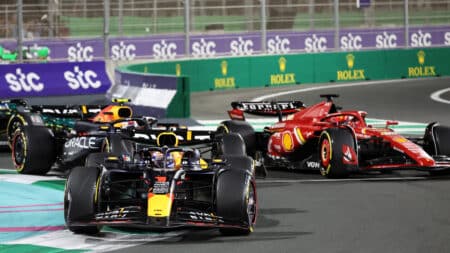
Which Red Bull will show up in Jeddah? - What to watch for at Saudi GP
Can Red Bull rebound from its poor Bahrain showing? And will it be Piastri or Norris leading McLaren's charge? Here's the five themes to watch for at the Saudi Arabian GP
What happens when ten technical departments set their considerable brainpower to pushing the boundaries of F1’s new 2021 regulations?
So the brave new world has been presented, a utopian vision representing a future F1 with a fairer income distribution, sexier-looking cars that can race each other more closely and where the driver counts for more. But sitting in the shadows are a bunch of brilliant minds looking to subvert the very intent of the new regulations for 2021-onwards. How will it all play out?
Given that the regulations were approved unanimously by the FIA World Motor Sport Council the previous day, and that Ferrari sits on that council, then we can probably assume the Scuderia is not going to press its nuclear veto button. So barring something left-field like a new championship (and the murmurings of that seemed to have died down), these regulations represent the first true post-Ecclestone F1.
There are a whole raft of changes to limit the advantage of greater spend, but a whole lot of clever people trying to find a way around them
“F1 needs to be saved from itself,” points out Ross Brawn. “The rewards for success are so great that it’s justified more and more spend from the big teams. Even they recognise the need for a cost control.” These regs represent F1 grabbing the nettle of technical, financial and sporting challenges that have been building for years. All in one hit.
There are a lot of firsts here. It’s the first time a cost cap has been written into the regulations, the first time a set of technical regulations have been fully researched and simulated beforehand – and that simulation suggests an age-old problem of F1 may have been solved: the ability to follow closely without losing so much downforce that you are slower through the corners than the car you’re trying to overtake.
At one car length behind, a current car loses 45% of its downforce. The simulated 2021 car loses only 14%. The current car loses significant performance even from much further behind than that – with a 21% loss at eight car lengths, a distance at which the 2021 car would be barely affected.
Key to achieving this – if indeed it translates from simulation into reality once it’s been through the filter of 10 white-hot technical departments – has been to standardise some key aerodynamically sensitive body surfaces and to ban barge boards. Venturi channels within the floor converge to a massive diffuser. This ensures that a greater proportion of the total downforce is created by the underbody (but there is a limit to how effective you can make the diffuser before it begins to damage the wake) which gives a much cleaner wake.
More on the 2021 rules
The distinctive ‘mud guards’ above the wheels are to direct the air inwards and thus prevent teams from getting the wheel wake as far outwards as possible – which they do now, so as to keep that messy wash from interfering with the nice clean flow that’s being accelerated down the bodysides. But in the process that creates a more disrupted wake and contributes to the downforce loss of the car behind.
Another feature limiting how far the airflow can be pushed away from the car is a heavily-prescribed (but not standardised) front wing. The wing elements transition to the endplate with a very gentle curve, thereby limiting the creation of powerful vortexes currently used to drive that wash outwards.
The aim of the research to desensitise the crucial aerodynamic areas of gain is to have a formula where, beyond a certain point, how you spend the money is more important than how much you spend – by making the difference between a big team spend and a smaller one a matter of tenths rather than seconds.
Will that prove to be the case? There are a whole raft of sporting changes designed to limit the performance advantage of greater spend, but a whole lot of clever people trying to find a way around all of these regulations. Brawn emphasises that they are subject to tweaking so as to achieve the desired result. All of which is bound to create some friction as teams adapt to the new realities.
“This is a turning point in F1,” Brawn believes, “but it’s not going to be a smooth road.”

Can Red Bull rebound from its poor Bahrain showing? And will it be Piastri or Norris leading McLaren's charge? Here's the five themes to watch for at the Saudi Arabian GP

McLaren's breakthrough in a near-four-year-old ruleset shows F1 rules convergence is a myth – just like Sebastian Vettel, Red Bull and Renault did in 2013, writes Mark Hughes

Madrid finally has a consortium to build the new Formula 1 circuit that will host the 2026 Spanish GP

Helmut Marko caused a stir after the Bahrain GP with his worries that Max Verstappen could leave Red Bull early. But how real are those fears?